 This article analyzes the question of whether return on equity (ROE) or return on capital (ROC) is the better guide to performance of an investment.
This article analyzes the question of whether return on equity (ROE) or return on capital (ROC) is the better guide to performance of an investment.
ROE vs ROC
Contents
We’ll start with an example. Two brothers, Abe and Zac, both inherited $10,000 and each decided to start a photocopy business. After one year, Apple, the company started by Abe, had an after-tax profit of $4,000. The profit from Zebra, Zac’s company, was only $3,000. Who was the better manager? I.e., who provided a better return? For simplicity, suppose that at the end of the year, the equity in the companies had not changed. This means that the return on equity for Apple was 40% while for Zebra it was 30%. Clearly Abe did better? Or did he?
There is a little more to the story. When they started their companies, Abe took out a long-term loan of $10,000 and Zac took out a similar loan for $2,000. Since capital is defined as equity plus long-term debt, the capital for the two companies is calculated as $20,000 and $12,000. Calculating the return on capital for Apple and Zebra gives 20% (= 4,000 / 20,000) for the first company and 25% (= 3,000 / 12,000) for the second company.
So for this measure of management, Zac did better than Abe. Who would you invest with?
Perhaps neither. But suppose that the same benefactor who left money to Abe and Zac, also left you $100 with the stipulation that you had to invest in the company belonging to one or other of the brothers. Who would it be?
Most analysts, once they have finished talking about earnings per share, move to return on equity. For public companies, it is usually stated along the lines that equity is what is left on the balance sheet after all the liabilities have been taken care of. As a shareholder, equity represents your money and so it makes good sense to know how well management is doing with it. To know this, the argument goes, look at return on equity.
Return on Capital versus Return on Equity Example
Let’s have a look at your $100. If you loan it to Abe, then his capital is now $20,100. He now has $20,100 to use for his business. Assuming that he can continue to get the same return, he will make 20% on your $100. On the other hand, if you loan it to Zac, he will make 25% on your money. From this perspective, Zac is the better manager since he can generate 25% on each extra dollar whereas Abe can only generate 20%.
The bottom line is that both ratios are important and tell you slightly different things. One way to think about them is that return on equity indicates how well a company is doing with the money it has now, whereas return on capital indicates how well it will do with further capital.
But, just as you had to choose between investing with Abe or Zac, if I had to choose between knowing return on equity or return on capital, I would choose the latter. As I said, it gives you a better idea of what a company can achieve with its profits and how fast its earnings are likely to grow. Of course, if long-term debt is small, then there is little difference between the two ratios.
Warren Buffett (the famous investor) is well known for achieving an average annual return of almost 30 percent over the past 45 years. Books and articles about him all say that he places great reliance on return on equity. In fact, I have never seen anyone even mention that he uses return on capital. Nevertheless, a scrutiny of a book The Essays of Warren Buffett and Buffett’s Letters to Shareholders in the annual reports of his company, Berkshire Hathaway, convinces me that he relies primarily on return on capital. For example, in one annual report he wrote,”To evaluate [economic performance], we must know how much total capital—debt and equity—was needed to produce these earnings.” When he mentions return on equity, generally it is with the proviso that debt is minimal.
ROC and ROE Formulas
If your data source does not give you return on capital for a company, then it is easy enough to calculate it from return on equity. The two basic ways that long-term debt is expressed are as long-term debt to equity (“DTE”) and as long-term debt to capital (“DTC”). (DTC is also referred to as the capitalization ratio.) In the first case, return on capital ROC is calculated from return on equity ROE by
ROC = ROE / (1 + DTE)
and in the second case by:
ROC = ROE * (1 - DTC)
For example, in the case of Abe, we saw DTE = 10,000 / 10,000 = 1 and ROE = 40% so that, according to the first formula, ROC = 40% / ( 1 + 1) = 20%. Similarly, DTC = 10,000 / 20,000 = 0.5 so that by the second formula, ROC = 40% (1 – 0.5) = 20%. You might like to check your understanding of this by repeating the calculations with the results for Zac’s company.
If you compare return on equity against return on capital for a company like General Motors with that of a company like Gillette, you’ll see one of the reasons why Buffett includes the latter company in his portfolio and not the former.
Article Credits:
Contributed-By: John Price
